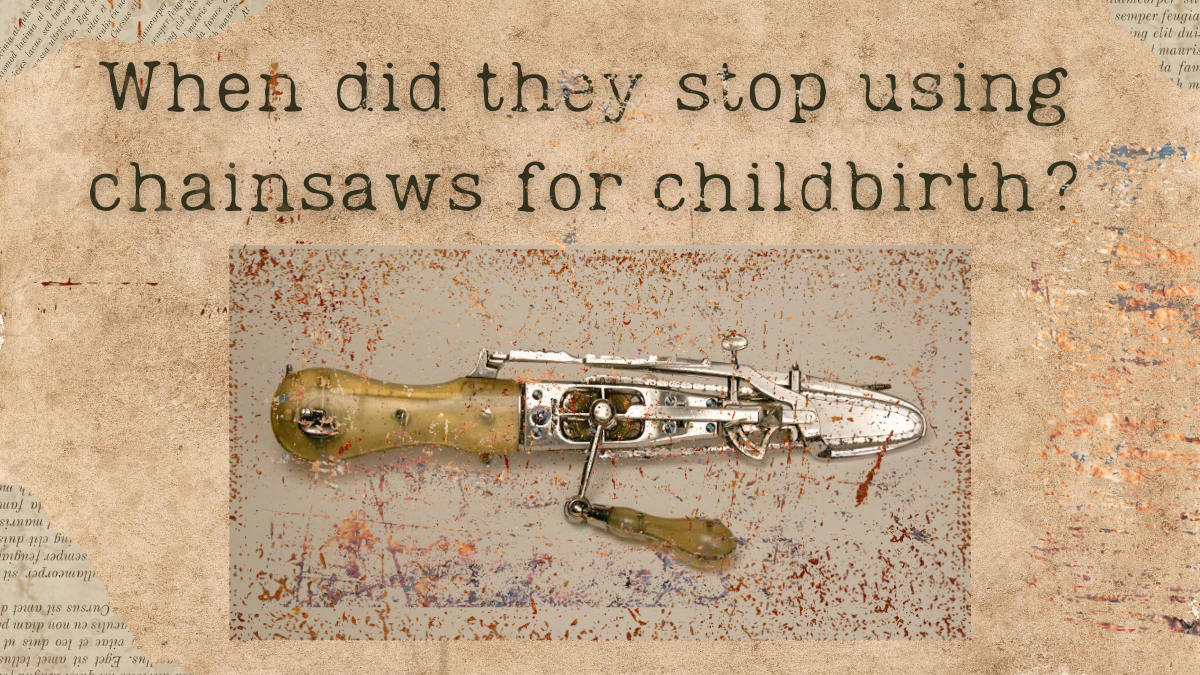In the shadowy corridors of history, a chilling practice defied reason: chainsaws in the delivery room! Brace yourself for a journey into the bizarre world of unconventional childbirth methods.
In the distant past, well before the age of modern medicine, childbirth was a realm shrouded in mystery and danger. While we might associate the process with sterile hospital rooms and skilled healthcare professionals today, it wasn’t always this way.
In fact, there was a time when the idea of using chainsaws during childbirth was not as outlandish as it may sound today. Imagine a world where surgical precision was in the early stages of development. Where childbirth complications often end in tragedy. In these dire circumstances, some desperate souls turned to unconventional methods, including using chainsaws.
It may sound like a gruesome scene from a horror movie, but it’s a fascinating chapter in the history of obstetrics. This article delves into the bizarre and dangerous world of childbirth practices of yesteryears, where chainsaws played a surprising role.
In our exploration of unconventional childbirth methods, we’ll delve into the historical practices that might leave you wondering, “When did they stop using chainsaws for childbirth?” We’ll also examine the reasons behind such methods, the associated risks, and how modern medicine ultimately transformed the childbirth experience into the safe and sterile environment we know today.
When did they stop using chainsaws for childbirth?
To figure out why they thought about using chainsaws for childbirth, let’s go back to a time when medicine wasn’t as good as it is now. Imagine this: it’s the 1700s and 1800s, and hospitals aren’t as clean and safe as they are today.
During childbirth, doctors faced challenging situations. Sometimes, babies would get stuck during delivery, causing immense distress for both the mother and the baby. The only option they had was to perform a procedure called a symphysiotomy – basically, cutting through the pelvic bone to make more space. However, this was not an easy task with the tools available at the time.
- Enter the chainsaw
- The chainsaw procedure
- The risks and dangers
- The decline of chainsaw childbirth
- Modern medicine and childbirth
- Lessons learned
Enter the chainsaw
In this gloomy medical landscape, someone had the wild idea to use a chainsaw for symphysiotomy. Yes, you read that right – a chainsaw. It seems crazy now, but back then, chainsaws were seen as a tool that could potentially make these surgeries quicker and less agonizing. Chainsaws were invented to cut through wood, and some thought,
“Hey, if it works on trees, maybe it’ll work on bones too.”
The chainsaw procedure
So, how did this chainsaw childbirth procedure work? Well, first, doctors had to sterilize the chainsaw blade. Then, they would make an incision in the mother’s pelvis using the chainsaw. The goal was to create more space for the baby to pass through. It sounds gruesome, but the truth is, it was.
The risks and dangers
Using chainsaws for childbirth was a risky business. The procedure was fast, but it came with a host of problems. Infections were a big concern because the sterilization methods of the time were far from perfect. Additionally, the rough cuts made by chainsaws could lead to long-term pain and complications for the mothers.
The decline of chainsaw childbirth
Thankfully, this horrifying practice didn’t last long. As medicine got better and doctors learned more about keeping things clean, they saw that using a chainsaw for childbirth was too risky. They looked for safer and better ways, and this led to the creation of modern surgery methods and tools.
Modern medicine and childbirth
In the 1900s, when they started using anesthesia, antibiotics, and safer surgery methods, they stopped using chainsaws for childbirth. Doctors could now safely do cesarean sections and other procedures without needing to use such extreme methods from before.
Lessons learned
The story of chainsaws in childbirth shows how much medicine has improved. It’s scary to think about using a chainsaw during birth, but we must remember that medical knowledge improves with time. What seems like a bad idea today might have been the only choice in the past.
Chainsaws in childbirth didn’t last long due to their complications outweighing their advantages, and ultimately, this practice was discontinued in the early 20th century. So there you have it- the bizarre and chilling use of chainsaws in childbirth. Thankfully, we now live in an age of advanced medical care, where childbirth is much safer and less frightening.
Were chainsaws made for C-sections?
A C-section, called a cesarean section, is a surgery doctors do to deliver a baby. They do it when a regular birth could be too risky for the baby or the mother. You might wonder why anyone thought about using chainsaws for this.
A long time ago, before modern hospitals and good surgical tools, having a baby was more dangerous. Sometimes, a baby would get stuck inside the mother during birth, and doctors needed to act quickly to get it out. They thought a chainsaw would be faster because it could cut through the pelvic bone and help the baby come out.
- How did the surgery work?
- Problems with chainsaws
How did the surgery work?
Here’s how it worked
- They would take a chainsaw and make it as clean as possible, kind of like how you clean a kitchen knife before using it.
- Then, they would use that chainsaw to cut through the mom’s pelvic bone to create more space for the baby to come out.
Problems with chainsaws
You can probably guess that using a chainsaw for this was not a great idea. There were a lot of problems with it, such as:
Infections
The chainsaws weren’t as clean as they needed to be, and that led to infections in the mother’s body.
Rough cuts
Chainsaws made rough cuts, and these rough cuts could cause long-term pain and trouble for the new mothers.
Risk
Chainsaws are not meant for delicate medical work, so using them was extremely risky.
As time went on, people in the medical field realized that using chainsaws for childbirth was a terrible idea. With advancements in medicine, they developed much safer and better ways to help mothers and babies during childbirth. They found out how to use clean and sterile tools and came up with safer surgeries, like C-sections.
Ultimately chainsaws were never made for C-sections or any kind of medical procedures. They were used very briefly in the past when medical knowledge and tools were not as advanced. Thankfully, we’ve come a long way in the world of medicine, and now, surgeries like C-sections are much safer for both mothers and babies.
Childbirth safety: What is the cut made during childbirth?
The “cut” made during childbirth is known as an Episiotomy or perineal incision. When a baby is born, it needs to pass through the mother’s birth canal, which is the pathway from the womb to the outside. While the perineum can stretch to accommodate the baby, there are times when it doesn’t stretch enough.
When it doesn’t stretch enough, it can tear, causing pain and a longer healing process compared to a deliberate cut. Therefore, in certain situations, healthcare professionals like doctors or midwives might create a small, controlled incision in the perineum to facilitate an easier delivery and prevent a more extensive and painful tear.
The surgical process
Here’s how it works:
- The healthcare provider numbs the area with local anesthesia so the mother doesn’t feel pain.
- Then, they make a small, straight cut with special scissors or a scalpel. It’s usually just a few centimeters long.
- This cut creates more space for the baby’s head to come out without putting too much pressure on the perineum.
When is an Episiotomy needed?
Not every mother needs an Episiotomy, and it’s not done routinely. It’s usually considered if:
- The baby’s head is too big to fit through the birth canal.
- The baby is in distress and needs to be born quickly.
- There’s a risk of a severe tear without the cut.
Recovery
After the baby is born, the healthcare provider stitches up the cut. These stitches dissolve on their own, so there’s no need to remove them later.
Recovery from an Episiotomy can vary. Some mothers might feel a little sore for a while, but the discomfort usually gets better with time. Keeping the area clean and following any care instructions from the healthcare provider can help with healing.
Episiotomy and chainsaws: A Glimpse into childbirth’s drastic past
In the past, when childbirth practices were far less advanced, doctors faced a challenging situation when a baby needed to be delivered, and the mother’s perineum didn’t stretch enough. Here is a complete breakdown of how they dealt with this complication:
- An Episiotomy is performed to deal with this complication. A small, controlled cut is made with a sharp, clean knife. The healthcare provider would make this small cut in the perineum, measuring just a few centimeters.
- This cut is carefully done, often with anesthesia, to numb the area and help the baby’s head pass through more easily. It is a precise and controlled adjustment to ensure a safe and less painful childbirth experience.
- Now, contrast this with the use of chainsaws in the past. Chainsaws were never meant for medical procedures, and using them for childbirth was a drastic and dangerous approach. Imagine trying to make that same adjustment, but instead of a small, controlled cut, a chainsaw was used.
- Chainsaws are massive, noisy tools designed for cutting through tough objects like trees. They don’t make neat cuts, and cleaning them well for medical use was also a big challenge
- So, while an Episiotomy was a carefully planned and relatively minor procedure performed by trained healthcare providers to prevent tears during childbirth, using a chainsaw for the same purpose would be like using a bulldozer to trim a delicate flower.
- It was not only terrifying but also incredibly risky, leading to infections, complications, and long-term pain for the mothers involved.
The Surprising evolution of chainsaws: A tale of birth and timber
Let’s take a journey through time to explore how chainsaws went from delivering babies to felling trees! We will explore:
- Before modern medicine
- Enter the chainsaw
- Scottish innovation: Aitkens flexible chainsaw
- Gigli’s twisted wire saw: Another evolution
- Decline of chainsaws in childbirth
- The chainsaw’s transition to timber
- Ending
Before modern medicine
Before the days of modern medicine, giving birth was risky, especially when you consider the absence of antibiotics, anesthesia, and proper hygiene practices. Complicated labor situations often lead to life-threatening situations for both mothers and babies.
Enter the chainsaw
In the 18th century, a French medical doctor named Jean-René Sigault introduced an unusual solution to the problem of babies getting stuck in the birth canal. Inspired by historical accounts of a “diastasis of the pubis,” Sigault’s idea was to surgically separate the pelvic joint to create more space for the baby to pass through safely.
In 1777, he performed the first-ever symphysiotomy, a procedure that saved both the mother’s and baby’s lives. However, it was far from perfect and came with significant risks and complications.
Scottish innovation: Aitkens flexible chainsaw
Fast forward to 1785, when Scottish doctors John Aitken and James Jeffrey improved the symphysiotomy method. They introduced a tool that would later be known as the Aitkens flexible chainsaw. This chainsaw was designed to make removing the mother’s pelvic bone during childbirth quicker and less traumatic than using traditional surgical instruments.
The Aitkens flexible chainsaw featured a fine serrated chain with teardrop-shaped handles on both ends. It allowed doctors to guide the chain behind the pubic bone, after which they could move their hands back and forth to “saw” through the pelvic bone more efficiently and with greater precision.
Gigli’s twisted wire saw: Another evolution
In the 1890s, Italian obstetrician Leonardo Gigli introduced a twisted wire saw. While similar in function to the Aitkens saw, Gigli’s version featured T-shaped handles that were easier to grasp and a chain with finer, more easily positioned teeth. This tool became valuable not only for symphysiotomies but also for amputations and other bone-cutting operations.
Decline of chainsaws in childbirth
In the early 1900s, fewer symphysiotomies were done because doctors improved medical procedures, hospitals got cleaner, and they used general anesthesia. This made C-sections safer and more preferred by people.
The chainsaw’s transition to timber
Now, you might wonder when chainsaws finally leapt from childbirth to timber. The turning point came in 1926 when German mechanic Andreas Stihl patented the first electric chainsaw designed for logging purposes. This was followed by a gas-powered version a few years later. However, these early chainsaws required multiple operators.
The true breakthrough came in the 1950s with the development of the first one-person chainsaw, making timber cutting significantly more efficient and accessible. This innovation paved the way for modern chainsaws, forever changing the world of forestry and woodworking.
Ending
Ultimately, chainsaws had a rather unusual beginning, starting as medical instruments used in childbirth to later becoming indispensable tools in the timber industry. While the use of chainsaws in childbirth is now a distant and bizarre memory, the legacy of these versatile machines lives on in the world of forestry and beyond. It’s a testament to how inventions can evolve and find their place in unexpected places throughout history.
FAQs
Was the chainsaw used in childbirth?
Yes, chainsaws were used in childbirth in the past, particularly in situations of obstructed labor when there were limited medical options. However, this practice was highly unconventional, risky, and no longer a part of modern medical procedures.
What year was the chainsaw invented for childbirth?
The use of chainsaws in childbirth can be traced back to the 18th century when French doctor Jean-René Sigault introduced the concept of symphysiotomy (an outdated procedure today). Chainsaws were later adapted for use in this surgical procedure to assist in childbirth during the late 1700s and early 1800s.
Were chainsaws used for pregnancy?
Chainsaws were not used specifically for pregnancy. They were employed in certain surgical procedures like symphysiotomies, which aimed to address complications during childbirth when the baby was stuck in the birth canal. Chainsaws were used as a last resort during such childbirth emergencies.
Is a C-section cut or rip?
A Cesarean section (C-section) is a controlled and precise cut rather than a rip, and it is done under anesthesia to minimize pain and discomfort for the mother. It is done to prevent a traumatic birth and save both the mother and the baby.
Conclusion
In medical history, the use of chainsaws in childbirth stands as a stark reminder of the lengths to which humanity once went to overcome obstetric challenges. While this represents a desperate chapter, it also underscores the incredible evolution of medicine. Today, we’re grateful for safer, precise procedures that prioritize the well-being of both mothers and babies, leaving chainsaws far behind in the past.












